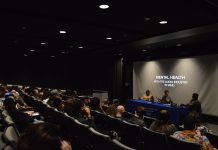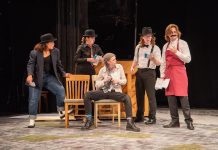Andrea Miller teaches Intro to Sociology and Intro to Human Rights this Spring semester. These classes are beginner classes that follow a general curriculum. But in Miller’s class, she changes things up a bit for her students.
In these introduction courses, Miller makes a point to cover sexual assault in her classroom, even though it is not necessarily a part of the way the classes are written to be taught.
“I kind of just keep it as a part of my teaching always because students need to know,” Miller said. “I just make it a part of what I do.”
Teaching awareness
Miller fits this learning into her teaching through videos and literature. She particularly has her students read work from one of her faorite sociologists Lisa Wade, the author of American Hookup: The New Culture of Sex on Campus.
The book features in-depth studies on what factors play into the cause of college sexual assault and what to do about it, using socially scientific research. After reading, the students follow-up with discussion about the topic. Miller is not the only one who incorporates this into her teaching.

Sociology professor Danielle MacCartney teaches Social Movements and Deviants and Social Control this semester. MacCartney has students in her classes watch the video “Rape Myths on Trial”. It features an attorney in Colorado who deals with cases of sexual assault and talks about her horrific experiences of victims being blamed in cases in which they, according to the video, should not be blamed. She said she always tries to fit the film into the course because it is important to recognize the horrors of victimhood.
“It’s such a problematic issue,” MacCartney said. “Our beliefs about certain categories of people really matter when it comes to sexual assault, and it comes to who we think of as victims of sexual assault and who we think of as deserving sexual assault or having asked for sexual assault.”
In 2015, MacCartney did a study on the role institutional factors have on on-campus reported rape, and what she found has helped shape how she teaches this topic in her classes today. One of the factors in the study included alcohol. Campus Safety Magazine sexual assault statistics show that 1 in 3 of the perpetrators in cases of sexual assault are intoxicated. While studying alcohol as one of these institutional factors on college campuses (whether or not the campus allows alcohol on the premises), she ran into some problems.
Bars off campus are not included in the study, neither are places like fraternity houses; this, and the fact that the study is only for reported rapes. According to the Rape Abuse and Incest National Network (RAINN), 1 in 4 women get raped on college campuses and only 3 out of 4 of those survivors report it. So when it came to studying the outcome of something that barely ever occurs, MacCartney speaks to how it left a gap in the research.
“[Having unanswered questions] is the take-home message of any social science research,” MacCartney said. “Human beings are messy, and it’s difficult to try to disentangle who does what and when and why. “
MacCartney did find in her study, however, that the likelihood of campus sexual assault goes up significantly when there are male organized groups like fraternities on college campuses, which she said had a bigger influence in the outcome. The study looked at this factor in terms of rape culture that is often present in male-only groups.
“Part of our cultural norms about what it means to be appropriately masculine, often centers around making outrageous statements about sexual proclivities and sexual prowess,” MacCartney said. “And often, you know, demoralizing or debasing women at the same time.”
#MeToo
As it has widely swept across the nation, the hashtag #MeToo brought attention to the survivors of sexual harassment, sexual assault and consent in October 2017. Since then, there has been a unique and controversial conversation about sexual assault awareness. Terri Reilly, a sociology professor at Webster, wanted to bring this conversation not only to her classroom, but also to the entire student body.
Reilly’s Social Movements class that focuses on movements and the impact of technology. She has her students research sexual violence and harassment statistics, look at what is going on within the #MeToo movement and then develop a survey that asks the student body questions that pertain to real – life sexual harassment situations that students could understand in a campus setting. The questions know no gender, race or class – the examples in the survey consist of phrases like ‘student X’ and ‘student Y’
“The goal is to sort of take the pulse of the student body,” Reilly said. “We ask the students what their ideas are for solutions. We are not trying to cure or eliminate sexual violence because it’s unrealistic to think that we are going to eliminate it.”
Miller said she loves the #MeToo movement because it distinguishes the language factor when talking about sexual assault. The movement differentiates the term “rape” and “sexual harassment” as two different things, which, Miller says, is essential when dealing with how universities talk about it.



